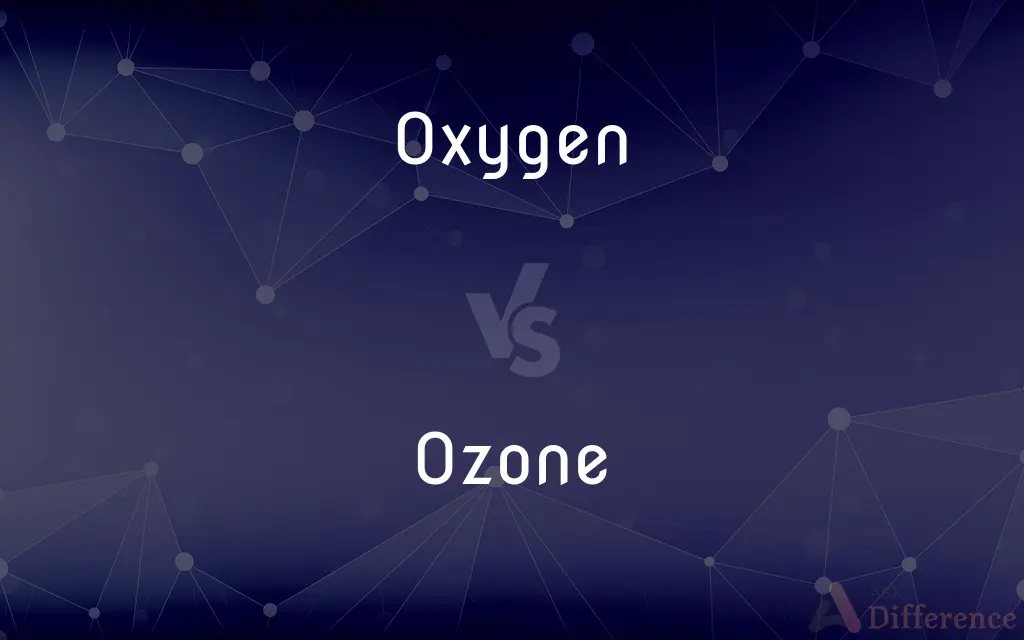Oxygen vs. Ozone — What's the Difference?
By Maham Liaqat & Urooj Arif — Updated on March 14, 2024
Oxygen is essential for life, while ozone protects life by absorbing UV radiation.

Difference Between Oxygen and Ozone
Table of Contents
ADVERTISEMENT
Key Differences
Oxygen (O2) is a colorless, tasteless, and odorless gas essential for most life forms on Earth as it is a key element in the respiratory processes of most living cells. On the other hand, ozone (O3) is a molecule composed of three oxygen atoms, with a sharp smell and is a pale blue gas at room temperature.
While oxygen is crucial for combustion and is used in various industrial applications such as welding and steel making, ozone is known for its strong oxidizing properties and is used in water purification, air cleaning, and bleach manufacturing.
Oxygen is abundant in the Earth's atmosphere, making up about 21% of its volume, whereas ozone is found primarily in the Earth's stratosphere, where it forms the ozone layer that protects life on Earth by absorbing the majority of the sun's harmful ultraviolet radiation.
Oxygen is stable under standard conditions, while ozone is highly reactive and unstable, with a half-life of about 30 minutes in the lower atmosphere. This reactivity makes ozone both a pollutant at ground level, causing harm to living organisms, and a vital protective layer in the stratosphere.
Despite their differences, both oxygen and ozone play critical roles in sustaining life on Earth. Oxygen is vital for cellular respiration, while ozone shields the planet from harmful ultraviolet light.
ADVERTISEMENT
Comparison Chart
Composition
2 oxygen atoms
3 oxygen atoms
Color
Colorless
Pale blue
Smell
Odorless
Sharp, pungent
Role in Nature
Essential for respiration and combustion
Forms the ozone layer, absorbs UV radiation
Stability
Stable under standard conditions
Highly reactive and unstable
Compare with Definitions
Oxygen
A diatomic molecule that is essential for most life forms.
Humans breathe in oxygen to sustain bodily functions.
Ozone
A triatomic molecule known for its role in the ozone layer.
The ozone layer's depletion has raised concerns about increased UV exposure.
Oxygen
Colorless, tasteless, and odorless, making up 21% of the Earth's atmosphere.
Oxygen tanks are used in medical facilities for patients in need.
Ozone
Absorbs the majority of the sun's harmful UV radiation.
The thinning ozone layer has led to stronger UV rays reaching the Earth.
Oxygen
Acts as an oxidizer and is necessary for burning.
Fire needs oxygen to continue burning.
Ozone
Has a distinct sharp smell and a pale blue color.
Ozone generators are used to purify air and water.
Oxygen
Utilized in various processes like metal cutting and welding.
Oxygen torches are common tools in metal fabrication.
Ozone
At ground level, it is a harmful component of smog.
High ozone levels can cause respiratory problems in humans and animals.
Oxygen
Critical for the survival of aerobic organisms.
Aquatic plants release oxygen into water through photosynthesis.
Ozone
Used in water treatment and as a bleaching agent.
Ozone is an effective alternative to chlorine in swimming pools.
Oxygen
Oxygen is the chemical element with the symbol O and atomic number 8. It is a member of the chalcogen group in the periodic table, a highly reactive nonmetal, and an oxidizing agent that readily forms oxides with most elements as well as with other compounds.
Ozone
Ozone (), or trioxygen, is an inorganic molecule with the chemical formula O3. It is a pale blue gas with a distinctively pungent smell.
Oxygen
A colourless, odourless reactive gas, the chemical element of atomic number 8 and the life-supporting component of the air.
An oxygen supply
If breathing stops, there is no oxygen getting to the brain and the cells begin to die
Hydrogen and carbon in the fuel combine with the oxygen in the air to form carbon dioxide and water
Ozone
An unstable, poisonous allotrope of oxygen, O3, that is formed naturally in the ozone layer from atmospheric oxygen by electric discharge or exposure to ultraviolet radiation, also produced in the lower atmosphere by the photochemical reaction of certain pollutants. It is a highly reactive oxidizing agent used to deodorize air, purify water, and treat industrial wastes.
Oxygen
A nonmetallic element constituting 21 percent of the atmosphere by volume that occurs as a diatomic gas, O2, and in many compounds such as water and silica, and in iron ore. It combines with most elements, is essential for plant and animal respiration, and is required for nearly all combustion. Ozone, O3, is an allotrope of this element. Atomic number 8; atomic weight 15.9994; melting point -218.79°C; boiling point -182.9°C; gas density at 0°C 1.429 grams per liter; valence 2. See Periodic Table.
Ozone
(Informal) Fresh, pure air.
Oxygen
The chemical element (symbol O) with an atomic number of 8 and relative atomic mass of 15.9994. It is a colorless and odorless gas. Category:en:Oxygen
Ozone
(inorganic chemistry) An allotrope of oxygen (symbol O₃) having three atoms in the molecule instead of the usual two; it is a toxic gas, generated from oxygen by electrical discharge.
Greenhouse gas
Oxygen
Molecular oxygen (O2), a colorless, odorless gas at room temperature, also called dioxygen.
Ozone
Fresh air, especially that breathed at the seaside and smelling of seaweed.
Oxygen
(medicine) A mixture of oxygen and other gases, administered to a patient to help them breathe.
Ozone
(transitive) To treat with ozone.
Oxygen
(countable) An atom of this element.
Ozone
A colorless gaseous substance (O3) obtained (as by the silent discharge of electricity in oxygen) as an allotropic form of oxygen, containing three atoms in the molecule. It is a strong oxidizer, and probably exists in the air, though by the ordinary tests it is liable to be confused with certain other substances, as hydrogen dioxide, or certain oxides of nitrogen. It derives its name from its peculiar odor, which resembles that of weak chlorine.
Oxygen
(figurative) A condition or environment in which something can thrive.
Silence is the oxygen of shame.
They hoped to starve the terrorists of the oxygen of publicity.
Ozone
A colorless gas (O3) soluble in alkalis and cold water; a strong oxidizing agent; can be produced by electric discharge in oxygen or by the action of ultraviolet radiation on oxygen in the stratosphere (where it acts as a screen for ultraviolet radiation)
Oxygen
A colorless, tasteless, odorless, gaseous element of atomic number 8, occurring in the free state in the atmosphere, of which it forms about 23 per cent by weight and about 21 per cent by volume, being slightly heavier than nitrogen. Symbol O. Atomic weight 15.9994.
Oxygen
Chlorine used in bleaching.
Oxygen
A nonmetallic bivalent element that is normally a colorless odorless tasteless nonflammable diatomic gas; constitutes 21 percent of the atmosphere by volume; the most abundant element in the earth's crust
Common Curiosities
Can ozone be harmful to humans?
Yes, ground-level ozone can cause respiratory issues and is a component of smog.
Why is the ozone layer important?
The ozone layer shields the Earth from harmful ultraviolet rays, reducing the risk of skin cancer and other damage.
What is the primary difference between oxygen and ozone?
Oxygen is a diatomic molecule essential for life, whereas ozone is a triatomic molecule that protects against UV radiation.
Can ozone exist at ground level?
Ozone can exist at ground level, often as a result of pollution, and is harmful to living organisms.
What causes ozone depletion?
Chemicals like chlorofluorocarbons (CFCs) can cause the breakdown of ozone in the stratosphere.
What are the uses of ozone in industry?
Ozone is used in the bleaching of paper and textiles, and in the treatment of industrial waste.
Is oxygen reactive?
Oxygen supports combustion but is less reactive than ozone.
Can ozone be used in water treatment?
Yes, ozone is an effective disinfectant and is used in water purification processes.
How do humans affect the levels of ozone?
Human activities, such as the release of certain chemicals, can deplete stratospheric ozone and increase ground-level ozone.
How does ozone protect us from the sun?
Ozone in the stratosphere absorbs most of the sun's harmful ultraviolet radiation.
How is oxygen produced in nature?
Oxygen is produced by plants and algae through the process of photosynthesis.
What is the significance of oxygen in the atmosphere?
Oxygen is crucial for respiration in aerobic organisms and is vital for combustion processes.
How is industrial oxygen obtained?
Industrial oxygen is typically obtained through the fractional distillation of liquefied air.
What is the role of oxygen in water ecosystems?
Oxygen dissolved in water is crucial for the survival of aquatic life.
How can ozone levels be reduced in urban areas?
Reducing emissions from vehicles and industrial sources can help lower ground-level ozone concentrations.
Share Your Discovery

Previous Comparison
Christmas vs. Thanksgiving
Next Comparison
Enigmatic vs. MysteriousAuthor Spotlight
Written by
Maham LiaqatCo-written by
Urooj ArifUrooj is a skilled content writer at Ask Difference, known for her exceptional ability to simplify complex topics into engaging and informative content. With a passion for research and a flair for clear, concise writing, she consistently delivers articles that resonate with our diverse audience.
















































